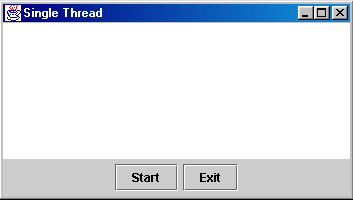|
 As soon as you click
the "Start" button, the
program calls the dangerousLoop() method
of remote object. Now, if you click the "Exit"
button, the application will not interact until the dangerousLoop()
method finishes the loop and returns. Run the program and see the result. As soon as you click
the "Start" button, the
program calls the dangerousLoop() method
of remote object. Now, if you click the "Exit"
button, the application will not interact until the dangerousLoop()
method finishes the loop and returns. Run the program and see the result.
 Figure 10.1 Figure 10.1

In the next example, I will show you how to make a responsive user
interface.
The source code needed for this example is stored in the examples\Multithread
directory. The "Multithread" directory
contains the following files:
- MultiThreadInterface.java
- MultiThreadImpl.java
- MultiThreadClient.java
- Compile.bat
- Rmicompile.bat
- RunServer.bat
- RunClient.bat
 Using
Threads Using
Threads
The simplest way to create a new thread is to inherit from the java.lang.Thread
class. In Java, every thread corresponds to an instance of the Thread
class. The most important method for Thread
is run(). The code in the run()
method is executed simultaneously with other threads. You should call
the start() method in your object to
start the thread.
If you want the thread to execute the run()
method of some object other than itself, you can implement the Runnable
interface. You still need to construct an instance of the Thread
class.
Remote Interface
 Listing 10.4
MultiThreadInterface Listing 10.4
MultiThreadInterface
import java.rmi.*;
//remote interface
public interface MultiThreadInterface
extends Remote {
//remote method
public String dangerousLoop()
throws RemoteException;
}
The remote interface declares only one method that returns a String
object.
|